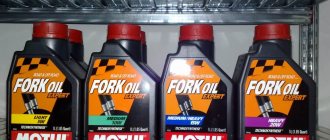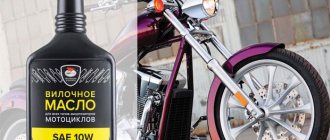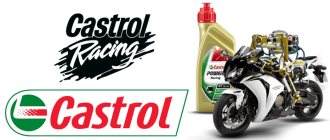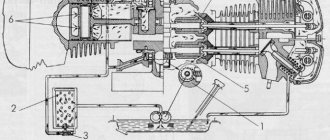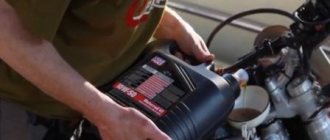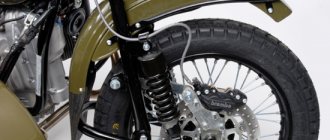A procedure such as changing the oil in a motorcycle fork frightens not only beginners, but also experienced drivers. Even professional mechanics often spend a lot of time doing this job because they have to deal with so many details. In addition, it is necessary to choose the right oil, which will allow you to obtain the necessary parameters of suspension rigidity. Therefore, it is necessary to approach such a procedure only after careful preliminary preparation.
Oil change intervals
Most manufacturers recommend changing the oil in the front suspension of a motorcycle every 12-15 thousand kilometers to ensure that the two-wheeled vehicle maintains good handling. However, experienced owners prefer to replace them simultaneously with scheduled repairs, which include installing new oil seals. This allows you to obtain optimal fork stiffness parameters without having to deal with time-consuming, labor-intensive adjustments.
It is recommended to change the oil after the motorcycle has been idle for the winter, since low temperatures may cause it to partially or completely lose its properties. If the motorcycle participates in sports competitions and the demands on its handling are very high, the frequency of replacing technical fluid should be reduced to 5 thousand kilometers. Experienced drivers recommend changing the fluid when the fork wear becomes noticeable. This is expressed in deep “dive” when braking, as well as in destabilization of the motorcycle at high speed. In such a situation, it is recommended to buy oil of higher viscosity in order to stiffen the suspension and also improve the handling of the two-wheeled vehicle.
Oil selection
Choosing fork oil is very difficult, despite the recommendations of motorcycle manufacturers. The problem is that motorcycle manufacturers often specify ideal viscosity parameters at operating oil temperatures that are many times higher than the temperature at which the fluid is poured into the fork. Therefore, it is necessary to pay attention not only to the standard designation of viscosity, but also to the coefficient of its change with increasing temperature. Such information is often indicated on the canister of liquid, and if it is missing, you will need to pay attention to the manufacturer’s website or to specialized materials published by technical experts.
Since the characteristics of oils from different manufacturers with the same SAE designation can vary significantly, it is better to choose one brand and remain faithful to it in the future. The first change is always made with oil with the same viscosity as specified in the vehicle’s operating instructions. With a significant reduction in fork stiffness, you will need to gradually increase the viscosity - by 2.5W or 5W with each subsequent replacement, depending on your personal preference. Most touring motorcycles recommend 10W oil, while sport and high-performance city bikes recommend 2.5-5W oil.
It is prohibited to use regular motor oil in the fork as it will help achieve the desired damping characteristics. On a canister with a special material you can find the inscription Fork Oil or Suspension Oil. You should beware of fakes, because with low-quality oil in the fork, the motorcycle can become uncontrollable, which will lead to a serious accident.
When choosing fork stiffness, you need to be guided by the type of roads on which the motorcycle will be used. By adding a thicker oil, you will get better damping characteristics and your vehicle will be more stable at high speeds. However, with an increase in rigidity, comfort will significantly decrease - on any major unevenness the driver will feel a “breakdown”, which can even throw the motorcycle off course. On the contrary, insufficiently viscous fork oil will cause significant vibrations, twitching, or even steering pull when cornering.
If the bike will only be used on quality intercity trails and race tracks, there is nothing wrong with significantly increasing the fork stiffness. However, for driving on country roads and city streets with poor quality coverage, such settings are no longer suitable. A special case is replacing technical fluid in a motocross motorcycle. For it you will have to buy a special technical fluid marked “Off-Road” on the canister. Using regular oil for road motorcycles can significantly reduce the energy capacity of the suspension or even lead to its failure.
Selecting fork oil viscosity for a motorcycle
Fork oil selection. The easiest and fastest way to choose fork oil is to contact our store consultants, but then this article would be too short. Method two, for those who are not looking for easy ways. First, a little theory in simple words.
The easiest and fastest way to choose fork oil is to contact our store consultants, but then this article would be too short. Method two, for those who are not looking for easy ways. First, a little theory in simple words.
Buying the right oil for your motorcycle is extremely important as it affects the performance of the suspension and prevents premature wear. So what kind of oil should you use in your fork? Most suspensions use viscosities between 2.5W and 20W (SAE). But due to the fact that the international SAE standard is highly blurred, 5w from one manufacturer can be the same viscosity as 7.5W from another.
Below is a table that uses the much more stringent Centistoke testing scale (Cst), or kinematic viscosity in Russian, so we can compare brands to each other with the highest accuracy. And I said that it’s easier to turn to specialists for selection. 
| Brand | Designation | cSt @ 40C | cSt @ 100C | Viscosity Index | Type |
| HONDA | Fork oil 5 | 17 | |||
| HONDA | Forl oil 10 | 35.2 | |||
| YAMAHA | KYB 01 | 15.6 | 3.45 | 150 | |
| YAMAHA | G5 | 17.7 | |||
| YAMAHA | G10 | 33.2 | |||
| YAMAHA | G15 | 47.3 | |||
| SUZUKI | L01 | 15.5 | |||
| SUZUKI | W-15 | 16.8 | |||
| SUZUKI | G10 | 33.3 | |||
| SUZUKI | G15 47.7 | 47.7 | |||
| KAWASAKI | KHL-15-10 | 15.3 | |||
| KAWASAKI | G5 | 17.9 | |||
| KAWASAKI | G10 | 33.9 | |||
| KAWASAKI | G15 | 49.5 | |||
| SHOWA | SS-05 | 15.7 | |||
| SHOWA | SS-7 | 16.6 | 3.77 | ||
| SHOWA | SS-8 | 36.8 | |||
| SHOWA | SS-15 | 20 | |||
| KAYABA | G10S | 37.2 | |||
| KAYABA | G15S | 55.2 | |||
| KAYABA | G30S | 116.1 | |||
| WHITE POWER | #5 | 22 | |||
| WHITE POWER | #7.5 | 33.4 | |||
| WHITE POWER | #10 | 48.1 | |||
| WHITE POWER | #15 | 67.8 | |||
| Castrol Fork Oil 5 | Fork & Shock Oil | 15 | 150 | Mineral | |
| Castrol Fork Oil 10 | Fork & Shock Oil | 32 | 150 | Mineral | |
| Castrol Fork Oil 20 | Fork & Shock Oil | 68 | 150 | Mineral | |
| Castrol Fork Oil S 2.5 | Fork & Shock Oil | 6.8 | 2.25 | 150 | Synthetic |
| Castrol Fork Oil S 5.0 | Fork & Shock Oil | 15 | 3.74 | 150 | Synthetic |
| Castrol Hyspin | Hydraulic fluid | ||||
| Ohlins 1302-01 | Front Fork Fluid #2 Extra Light | 7 | |||
| Ohlins 1311-02 | Front Fork Fluid #5 Light | 15 | |||
| Ohlins 1309 Made by Soki | Front Fork Fluid – Road & Track | 19 | |||
| Ohlins 1310 | Front Fork Fluid #10 Medium | 22 | |||
| Ohlins 1315 | Front Fork Fluid #15 Medium/Heavy | 35 | |||
| Ohlins 1320 | Front Fork Fluid #20 Heavy | 50 | |||
| Ohlins 1305 | Front Fork Fluid #5 Synt | 17 | Synthetic | ||
| Ohlins 1310 | Front Fork Fluid #10 Synt | 22 | Synthetic | ||
| Ohlins 1315 | Front Fork Fluid #15 Synt | 31 | Synthetic | ||
| Ohlins 1302 | Front Fork Fluid #2 | 7 | |||
| Ohlins 1311 25mm cart kit | Front Fork Fluid #4 | 15 | |||
| Ohlins 1310 | Front Fork Fluid #5 | 22 | |||
| Ohlins 1315 | Front Fork Fluid #10 | 35 | |||
| Ohlins 1320 | Front Fork Fluid #15 | 50 | |||
| Ohlins 1325 | Front Fork Fluid #20 | 99 | |||
| Ohlins 1309-31 | Front Fork Fluid – Road & Track 43 | 19 | |||
| Ohlins 00105 | Shock Absorber Fluid | 28 | |||
| Ohlins 01303-01 | Off Road Racing Shock Fluid – syn | 18 | Synthetic | ||
| Ohlins 01306-01 race 07 | Shock Absorber Fluid-race spec 07 | 14 | |||
| Bel-Ray HVI 3wt | Shock Oil | 11 | 3.85 | 296 | Synthetic |
| Bel-Ray HVI 5wt | Shock Oil | 19.5 | 6.66 | 300 | Synthetic |
| Bel-Ray HVI 10wt | Shock Oil | 33.5 | 10.00 | 306 | Synthetic |
| Bel-Ray HVI 15wt | Shock Oil | 49 | 13.90 | 297 | Synthetic |
| Bel-Ray High Performance Fork Oil 5 W | Fork Oil | 17.1 | 4.10 | 146 | Mineral |
| Bel-Ray High Performance Fork Oil 7W | Fork Oil | 29 | 5.20 | 110 | Mineral |
| Bel-Ray High Performance Fork Oil 10W | Fork Oil | 33 | 5.90 | 123 | Mineral |
| Bel-Ray High Performance Fork Oil 15W | Fork Oil | 53 | 7.50 | 103 | Mineral |
| Bel-Ray High Performance Fork Oil 20W | Fork Oil | 73.5 | 9.50 | 106 | Mineral |
| Bel-Ray High Performance Fork Oil 30W | Fork Oil | 105 | 12.00 | 104 | Mineral |
| Silkolene Maintain Fork Oil light 5 w | Fork Oil | 22.3 | 4.40 | 106 | Mineral |
| Silkolene Maintain Fork Oil Medium10 w | Fork Oil | 34.9 | 7.05 | 169 | Mineral |
| Silkolene Maintain Fork Oil Intermediate 15 | Fork Oil | 48.45 | 8.50 | 153 | Mineral |
| Silkolene Maintain Fork Oil Heavy 20 | Fork Oil | 67.7 | 8.75 | 101 | Mineral |
| Silkolene Maintain Fork Oil Extra Heavy 30 | Fork Oil | 105 | 11.64 | 101 | Mineral |
| Silkolene PRO RSF 2.5wt | Fork & Shock Oil | 13.6 | 5.80 | 464 | Semi Synthetic |
| Silkolene PRO RSF 5wt | Fork & Shock Oil | 26.7 | 9.50 | 372 | Semi Synthetic |
| Silkolene PRO RSF 7.5wt | Fork & Shock Oil | 37.19 | 11.50 | 322 | Semi Synthetic |
| Silkolene PRO RSF 10wt | Fork & Shock Oil | 47.36 | 13.70 | 303 | Semi Synthetic |
| Silkolene PRO RSF 15wt | Fork & Shock Oil | 92.95 | 19.50 | 235 | Semi Synthetic |
| 02 Silkolene Racing Fork Fluid | Fork Oil | 17.94 | 5.27 | 260 | Synthetic |
| 05 Silkolene Racing Fork Fluid | Fork Oil | 43.18 | 9.48 | 212 | Synthetic |
| Motul Shock Oil | Shock Oil | 16.1 | 6.20 | 400 | 100% Synthetic |
| Motul Factory Line – very light | Fork Oil | 15 | 3.50 | 112 | 100% Synthetic |
| Motul Factory Line – light | Fork Oil | 18 | 4.00 | 121 | 100% Synthetic |
| Motul Factory Line – light/medium | Fork Oil | 24 | 4.90 | 131 | 100% Synthetic |
| Motul Factory Line – medium | Fork Oil | 36 | 6.40 | 130 | 100% Synthetic |
| Motul Fork Oil Expert – light | Fork Oil | 17.9 | 3.90 | 112 | Semi/Synthetic |
| Motul Fork Oil Expert – medium | Fork Oil | 35.9 | 6.00 | 112 | Semi/Synthetic |
| Motul Fork Oil Expert – medium/heavy | Fork Oil | 57.1 | 8.30 | 116 | Semi/Synthetic |
| Motul Fork Oil Expert – heavy | Fork Oil | 77.9 | 10.10 | 111 | Semi/Synthetic |
| Maxima Racing Shock Fluid – Light | Shock Oil | 13.9 | 5.20 | 378 | Petroleum |
| Maxima Racing Shock Fluid – Medium | Shock Oil | 20.8 | 7.30 | 349 | Petroleum |
| Maxima Racing Shock Fluid – Heavy | Shock Oil | 28.9 | 9.40 | 334 | Petroleum |
| Maxima Racing Fork Fluid 85/150 5wt | Fork Oil | 15.9 | 3.50 | 150 | Petroleum |
| Maxima Racing Fork Fluid 125/150 7wt | Fork Oil | 26.7 | 5.40 | 151 | Petroleum |
| Maxima Racing Fork Fluid 165/150 10wt | Fork Oil | 32 | 6.30 | 151 | Petroleum |
| Maxima Racing Fork Fluid 235/150 15wt | Fork Oil | 46 | 8.50 | 154 | Petroleum |
| Maxima Fork Oil 5wt | Fork Oil | 15.9 | 3.50 | 150 | Petroleum |
| Maxima Fork Oil 10wt | Fork Oil | 32 | 6.30 | 151 | Petroleum |
| Maxima Fork Oil 15wt | Fork Oil | 46 | 8.50 | 154 | Petroleum |
| Maxima Fork Oil 20wt | Fork Oil | 65.6 | 12.90 | 201 | Petroleum |
| ELF Moto Fork Oil Syn 2.5 W | Fork & Shock Oil | 18 | 4.00 | 121 | Synthetic |
| ELF Moto Fork Oil Syn 5 W | Fork & Shock Oil | 23.3 | 4.80 | 130 | Synthetic |
| ELF Moto Fork Oil Syn 10 W | Fork & Shock Oil | 45.4 | 7.60 | 135 | Synthetic |
| Rock Oil SVI 2.5 | Fork & Shock Oil | 10 | 4.00 | 250 | Synthetic |
| Rock Oil SVI 5 (01) | Fork & Shock Oil | 22 | 5.30 | 200 | Synthetic |
| Rock Oil SVI 7.5 | Fork & Shock Oil | 24 | 6.80 | 250 | Synthetic |
| Rock Oil SVI 10 | Fork & Shock Oil | 32 | 6.50 | 170 | Synthetic |
| Rock Oil SVI 15 | Fork & Shock Oil | 48 | 9.00 | 160 | Synthetic |
| Rock Oil SVI 20 | Fork & Shock Oil | 68 | 10.70 | 140 | Synthetic |
| Golden Spectro Cartridge Fork Fluid – Very Light 85/150 | Fork Oil | 14 | 3.40 | 150 | Semi Synthetic |
| Golden Spectro Cartridge Fork Fluid – Light 125/150 | Fork Oil | 26 | 3.40 | 150 | Semi Synthetic |
| Spectro SPL ultra light | Shock Oil | 10.4 | 4.40 | 385 | |
| Spectro SPL very light | Shock Oil | 26.4 | 9.90 | 400 | |
| Spectro SPL light | Shock Oil | 47.27 | 16.76 | 381 | |
| Spectro SX 400 Shock & Fork | Fork & Shock Oil | 20.9 | 8.90 | 400 | |
| Spectro Fork Oil 5w | Fork Oil | 21.7 | 4.40 | 119 | Petroleum |
| Spectro Fork Oil 10w | Fork Oil | 32.8 | 5.60 | 111 | Petroleum |
| Spectro Fork Oil 15w | Fork Oil | 45.6 | 7.20 | 119 | Petroleum |
| Spectro Fork Oil 20w 20 | Fork Oil | 65 | 8.90 | 110 | Petroleum |
| Spectro Heavy Duty Fork Oil – Type E | Fork Oil | 64.9 | 8.90 | 385 | Petroleum |
| Spectro Heavy Duty Fork Oil – Heavy | Fork Oil | 141.2 | 14.10 | 400 | Petroleum |
| Morris Lubricants | Fork & Shock Oil | 22.9 | 7.70 | 350 | |
| Morris Lubricants | Fork & Shock Oil | 56.6 | 13.70 | 252 | |
| Klotz KL-505 | Fork & Shock Oil | 23.8 | |||
| Klotz KL-510 | Fork & Shock Oil | 32 | |||
| Klotz KL-515 | Fork & Shock Oil | 42 | |||
| Putoline HPX 2.5 | Fork & Shock Oil | 6.74 | 3.01 | 458 | Semi Synthetic |
| Putoline HPX 5.0 | Fork & Shock Oil | 22.5 | 5.07 | 162 | Semi Synthetic |
| Putoline HPX 7.5 | Fork & Shock Oil | 33.7 | 6.77 | 164 | Semi Synthetic |
| Putoline HPX 1.0 | Fork & Shock Oil | 50.1 | 8.64 | 151 | Semi Synthetic |
| Putoline HPX 15 | Fork & Shock Oil | 67.5 | 11.20 | 159 | |
| Putoline HPX 20 | Fork & Shock Oil | 99.4 | 14.60 | 155 | |
| Putoline HPX 30 | Fork & Shock Oil | 150 | 14.60 | 95 | |
| Motorex Racing Racing SD-1 | Shock Oil | 14.8 | 3.50 | ||
| Motorex Racing Fork Oil 2.5 | Fork Oil | 15.2 | 4.40 | 222 | Mineral |
| Motorex Racing Fork Oil 5.0 | Fork Oil | 21.8 | 5.50 | 209 | Mineral |
| Motorex Racing Fork Oil 7.5 | Fork Oil | 29 | 6.80 | 206 | Mineral |
| Motorex Racing Fork Oil 10 | Fork Oil | 32 | 7.20 | 200 | Mineral |
| Motorex Racing Fork Oil 15 | Fork Oil | 46 | 8.50 | 180 | Mineral |
| Motorex Racing Fork Oil 20 | Fork Oil | 68 | 9.10 | 110 | Mineral |
| Torco Racing Shock Fluid – Light | Shock Oil | 14.5 | 4.70 | 100% Synthetic | |
| Torco Racing Shock Fluid – Medium | Shock Oil | 31.82 | 9.57 | 100% Synthetic | |
| Torco Racing Fork Fluid - 5 | Fork Oil | 10.75 | 4.00 | Semi Synthetic | |
| Torco Racing Fork Fluid - 7 | Fork Oil | 16.1 | 5.05 | Semi Synthetic | |
| Torco Racing Fork Fluid - 10 | Fork Oil | 19.9 | 5.70 | Semi Synthetic | |
| Torco Racing Fork Fluid - 15 | Fork Oil | 33 | 8.40 | Semi Synthetic | |
| Torco Racing Fork Fluid - 20 | Fork Oil | 43.9 | 10.40 | Semi Synthetic | |
| Shell Advance Ultra 2.5 | Shock Oil | 8.6 | 3.60 | 100% Synthetic | |
| Shell Advance Ultra 5 | Shock Oil | 23.5 | 5.90 | 100% Synthetic | |
| Shell Advance Fork 5 | Fork Oil | 21 | 5.00 | 153 | Semi Synthetic |
| Shell Advance Fork 7.5 | Fork Oil | 22 | 2.90 | 153 | Semi Synthetic |
| Shell Advance Fork 10 | Fork Oil | 32 | 6.40 | 153 | Semi Synthetic |
| Shell Advance Fork 15 | Fork Oil | 46 | 8.20 | 154 | Semi Synthetic |
| Aero shell 31 | Military aero | 14.5 | 3.62 | ||
| Aero shell 41 | Military aero | 14.1 | 5.30 | ||
| Shell Tellus T15 | hydraulic oil | 15 | 5.30 | ||
| Shell Tellus 22 | hydraulic oil | 22 | |||
| Shell Tellus S (silver bearings) | hydraulic oil | ||||
| Esso Univis | J15 | ||||
| Esso Univis | J26 |
Return to list
Replacement procedure
Before changing the oil, be sure to look where the lower plug on the fork is located - the principle of performing the entire procedure depends on this. The following options are available:
- Down at the end;
- On the side at the bottom;
- The bottom plug is missing.
If the drain hole is located at the end of the fork, lift the motorcycle onto a support, remove the front wheel and install the rods strictly vertically. The lateral location of the plug allows you to repair the hydraulic system without removing the wheel, although you will have to lift the motorcycle in this case as well. If there is no bottom plug, you will need to remove the fork.
Having decided which oil to pour into the fork, first unscrew the upper plug, and then the lower one, after placing a vessel with a volume of at least 0.5 liters under each shock absorber. If you have to work on a motorcycle without a bottom plug, the removed fork will have to be turned over so that the oil comes out of it through a single hole. After draining the technical fluid, the fork must be washed - a special fluid or regular low-viscosity motor oil is suitable for this. Having done all this, blow the inside of the part with compressed air from a compressor or a special can.
A very important question is how much fluid to add to achieve ideal damping characteristics? The most common recommendations on the Internet suggest using 500 ml of liquid for each shock absorber. However, this is a very rough assumption that can make the motorcycle completely uncontrollable. To optimize the controllability of two-wheeled vehicles, it is worth focusing on such a parameter as the oil level from the top edge of the pipe. You can find it in the vehicle’s operating instructions or in specialized technical literature.
It is worth understanding that an oil pump with a measuring needle that prevents fluid from overflowing costs about $100 - not every motorcyclist is willing to pay such an expense. Therefore, a much better solution would be to build the necessary tool yourself, spending no more than 100 rubles on it. At the pharmacy, buy a 10-cc syringe and a catheter, which is a transparent tube that fits over the nose of the syringe. You will need a length of catheter equal to the distance found in the instructions. It will need to be tightly placed on the syringe spout to prevent oil leakage during operation.
First, you need to pour 500 ml of oil into the fork, or a little more if the catheter does not reach the top edge of the liquid. Then the syringe is applied to the pipe so that the base of its nose coincides with the cut line. All you have to do is pump out the excess oil that will interfere with the suspension adjustment. Remember that this procedure must be performed with the fork compressed in order to be able to accurately determine the required oil level. The cartridge should be installed at this point, but the spring does not need to be installed.
Responsible process
The controllability of the motorcycle, and, consequently, the safety of the driver and others depends on the correct selection of oil for the fork. It is best to follow the recommendations of the motorcycle manufacturer, but increase the viscosity of the technical fluid when components wear in order to achieve good damping characteristics. It is also worth paying attention to the oil change procedure - the ability to adjust the suspension and obtain optimal rigidity depends on its correct implementation. We must not forget about flushing the fork after draining the old oil - drops of technical fluid remaining inside and chips obtained from friction between the components can significantly affect the characteristics of the shock absorbers. If you are not sure that you can perform an oil change and suspension adjustment yourself, contact professional mechanics, since your interventions can only cause harm.
Pit bikes with oil filter
The seat and the oil filter itself are in the photo.
The steps for changing the oil are similar, only a couple of points are added.
- Before unscrewing the drain plug, remove the oil filter.
- After draining the oil, insert a new oil filter. Follow the sequence, different models can be arranged with a spring. We recommend that you treat the oil filter cover mounting bolts with a special liquid that will prevent them from being unscrewed.

